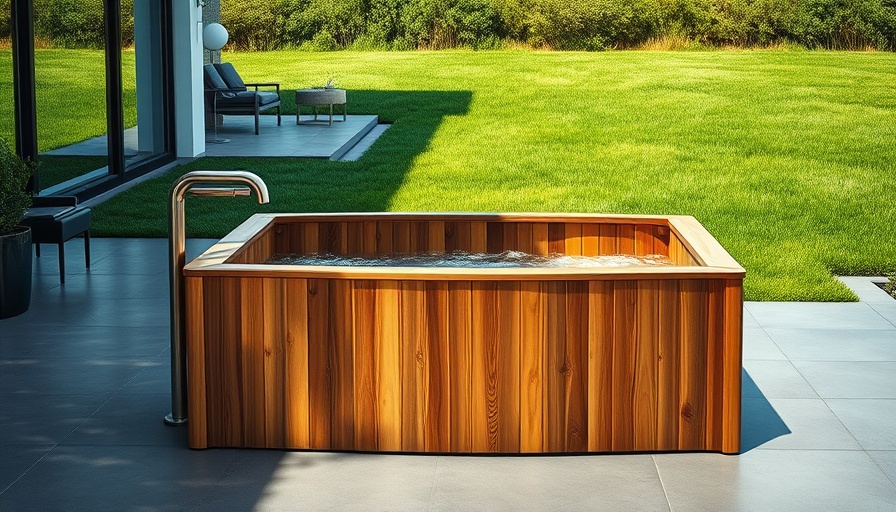
Discovering the Chill: The Rise of Cold Plunge Tubs
Cold plunge tubs are gaining popularity among wellness enthusiasts and homeowners alike, and for good reason. The practice of cold water immersion therapy has myriad benefits, ranging from enhanced immune function to improved mental health. As more people flock to spas, gyms, lakes, and oceans seeking the therapeutic effects of cold water, the desire for a private cold plunge experience in one’s own backyard is becoming a reality.
Unpacking the Benefits: Why Choose Cold Water Immersion?
The science behind cold water immersion is compelling. Studies suggest that cold exposure can boost circulation, reduce inflammation, aid in muscle recovery, and even help manage stress and anxiety. This simple yet powerful practice taps into our body's natural response systems, promoting resilience and well-being. With innovations in design and technology, cold plunge tubs now offer customized experiences, allowing users to set the ideal temperature and filtration systems, making them an attractive addition to any outdoor space.
Top Choices: Cold Plunge Tubs Perfect for Your Home
Here are some stunning and functional options available for those looking to enjoy the invigorating benefits of cold plunge therapy right within their premises:
- Tubmarine Stainless Steel Ice Bath: Priced at £19,450, this high-end option caters to UK and EU customers, offering durability and aesthetic appeal.
- Redwood Outdoors Pacific Cold Plunge Kit: At $6,499, this kit blends practicality with elegance, making it an ideal choice for outdoor aesthetics.
- Goodland Cold Tub: Materialized from stainless steel, this tub promises both longevity and effective water cleaning systems (contact for pricing).
- Polar Monkeys Cyber Barrel: Standing vertically, this tube demands attention at $6,800, combining style and function.
- BlueCube Modular Series Cold Plunge: Available for $23,999.99, this tub not only looks great but is also modular, featuring a sophisticated chilling, pumping, and filtering system.
- Renu Therapy Cold Stoic 3.0: Coming in at $10,299.99, this engaging tub oscillates between hot and cold water, allowing for a customized bathing experience managed via an app.
- Dynamic Cold Therapy Barrel: Affordable at $2,499, this cedar-clad option brings a touch of nature into your wellness routine.
- Walden Cold Plunge Concept: With a sleek aluminum design and priced at $15,000, this brand focuses on filtering and cleaning while ensuring precise temperature regulation.
- Lit Barrel Stainless Cold Plunge: This vertical tank combines style with function at $2,899, made from a combination of stainless steel and red cedar.
- Colderatti Chieftain Pro Plus: At $12,290, this top-tier model features an integrated hyper-chiller and water purification system.
Integrating Culture: Cold Plunge Tubs as Lifestyle Enhancers
As part of a growing wellness movement, cold plunge tubs symbolize more than just a fitness trend—they embody a lifestyle choice. They've become coveted elements in backyard sanctuaries, representing a commitment to health and self-care. From minimalists who prefer sleek designs to families looking to incorporate holistic health approaches, the diversity of cold plunge options allows various aesthetics and lifestyles to shine.
Future Forecast: What’s Next for Cold Plunge Tubs?
As we continue to emphasize health and wellness, the future of cold plunge tubs looks promising. Innovations will surely follow, particularly in sustainability and technology integration. Expect to see more eco-friendly materials and smart features that promise to make the cold plunge experience even more effortless and enjoyable. With the surge in interest, investment in this sector might drive down costs, making it more accessible.
Actionable Insights: Maximizing the Benefits of Your Cold Plunge
For those considering adding a cold plunge tub to their home, understanding best practices is crucial. Prioritize placement in a peaceful outdoor location that encourages relaxation. Maintain consistent temperatures to maximize its health benefits and ensure that water quality is monitored to maintain hygiene. Lastly, integrating the plunge into a broader wellness routine—perhaps after workouts or as a meditation practice—can amplify its benefits.
Don't Miss Out!
If you’re intrigued by the idea of bringing a cold plunge into your life, now might be the perfect time to explore your options. The benefits of cold water therapy are extensive, and the added accessibility of home-based solutions makes it a trend worth considering.
 Add Row
Add Row  Add
Add 




Write A Comment